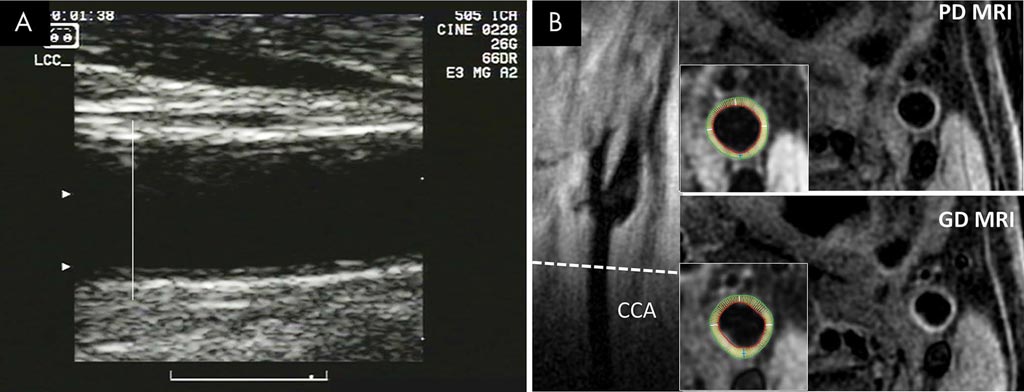Carotid Artery MRI Assesses CVD Risk Better Than Ultrasound
By MedImaging International staff writers
Posted on 12 Nov 2018
A new study suggests that measuring carotid wall thickness using magnetic resonance imaging (MRI) improves cardiovascular disease (CVD) risk assessment.Posted on 12 Nov 2018
Researchers at the U.S. National Institutes of Health (NIH, Bethesda, MD, USA), Johns Hopkins University (JHU; Baltimore, MD, USA), Tufts University (Medford, MA, USA), and other institutions conducted a study that compared common carotid artery (CCA) intima-media thickness (IMT), as measured manually by using ultrasound, and semi-automatically by using MRI. The main aim was to examine associations with incident coronary heart disease (ICHD) and stroke.

Image: Ultrasound (A) and MRI (B) scans of the common carotid artery (Photo courtesy of Bruce Wasserman/ JHU).
The study enrolled 698 participants (mean age 63 years) without a history of clinical CVD from July 2000 to December 2013. CCA wall thickness was measured with ultrasound and both non-contrast proton-density–weighted MRI and intravenous gadolinium-enhanced MRI. During subsequent follow-up, the correlations between carotid artery wall thickness measurements and coronary heart disease and stroke were quantified to assess the associations between wall thickness measurements and CVD outcomes.
The results revealed that the association between wall thickness and CVD was stronger with both non-contrast and contrast-enhanced MRI than it was for ultrasound. Adjusted hazard ratios for ICHD, stroke, and CVD associated with per standard deviation increase in IMT were 1.10, 1.08, and 1.14, respectively. The corresponding associations for mean wall thickness measured with proton-density–weighted MRI were 1.32, 1.48, and 1.37, and for mean wall thickness measured with gadolinium-enhanced MRI were 1.27, 1.58, and 1.38. The study was published on October 9, 2018, in Radiology.
“The carotid artery serves as window into the cardiovascular system. Plaque developing in the carotid artery can contribute directly to a stroke,” said lead author Bruce Wasserman, MD, of JHU. “High-resolution MRI can tell us the stage of plaque in the wall and tell us about plaque features that could lead to stroke. It can also see the adventitia, a vessel layer that may have an important role in cardiovascular risk because small vessels proliferate there, leading to thickening of the artery, which may be responsible for early disease development and progression."
The carotid arteries are the two major arteries on either side of the neck that carry blood into the head and brain. They can become narrowed by as atherosclerosis, which often mirrors that of the coronary arteries. The carotids, however, are more easily imaged, making them potentially useful vessels for the assessment of the risk of strokes, heart attacks, and other adverse cardiovascular events. Ultrasound-based carotid IMT is the most widely used method to assess early-stage carotid atherosclerosis.
Related Links:
U.S. National Institutes of Health
Johns Hopkins University
Tufts University














